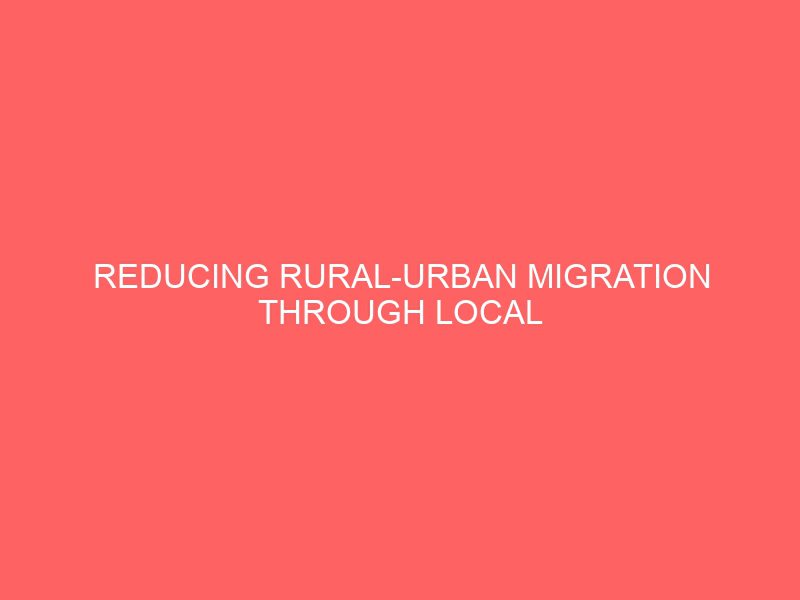Description
CHAPTER ONE
INTRODUCTION
1.1 Background of the Study
This research is on Reducing rural-urban migration through local economic development. There has been an increased migration of people from rural to urban areas in search of greener pastures. These urban economies however do not have the capacity to absorb and retain the continued inflows of migrants, either skilled or unskilled labour. This leads to the depopulation of rural settlements. It is usually the economically active the in rural areas that migrate out thereby increasing the poverty levels of those left behind.(Adepoju, 2010).
The decision to migrate in rural areas is usually influenced by push and pull factors. The pull factors attract migrants to urban centers while the push factors force them out of their communities of origin. These factors are influenced by the strength of the local economy. The availability of jobs and social amenities act as pull factor in urban center while the lack or inadequacy of these act as push factors in rural communities (de Haas, 2008).For instance, the absence of a rural credit market could push people to migrate to provide remittances in order to overcome the rural credit constraints and to finance rural productive investments (Katz and Stark, 1986). Rural to urban migrations could have a negative impact on rural areas by removing workers from productive rural economic activities. Rural-urban migration also has negative social consequences such as the deterioration of family, community structures and norms.
In post-independent Nigeria, there has been considerable growth of the urban population due largely to increased movement of populations from rural to urban areas (Centre for Migration Studies, 2011).
In Nigeria, rural areas are usually characterized by limited health and educational facilities, small industrial output, limited economic opportunities and poverty, especially non- agricultural employment.
These conditions usually motivate rural folks to migrate to towns and cities in search of greener pastures. Therefore, one significant way to stem the flow of rural-urban migration is to see to the development of rural areas (Nasiru, 1997) Rural areas fall within the jurisdiction of district assemblies and hence the district assembly in Nigeria has the ultimate task of promoting economic development at the local level.
The government of Nigeria shared Growth Development Agenda 2012-2013 plans indicated that it is developing special initiatives such as the Savannah Accelerated Development Authority (SADA) as a way of contributing to the improvement in infrastructure, especially at the local level. This is expected to lead to the creation of new economic poles especially in the rural areas. The initiative would enhance employment creation and income generation activities, which in the long term would contribute to the reduction of social, spatial and economic inequalities as well as rural-urban migration.
Government recognizes the weak employment generation capabilities at the district level and intends to, as a policy objective, mainstream the concept of local economic development planning at the district level. The strategy as stated earlier is to provide support in order to facilitate, develop and implement employment programmes at the local level based on natural resource endowments and competitive advantage (GSGDA, 2010:195)
Local Economic Development (LED) is a process that seeks to forge partnerships between local government and the private sector to stimulate investments that will eventually promote sustained high growth in a local community (National LED Policy, 2012).
LED focuses on the community’s comparative advantage such that it reaches its potential in relation to new market opportunities, and reduces obstacles to business expansion and creation (Internet Source: USAID website, accessed on 1st July, 2013)). Local Economic Development in the rural areas would help create new jobs, help communities retain existing jobs, and thus reduce rural-urban migration.
The present study examined the economic opportunities in rural areas that can be developed by promoting LED activities, which would help reduce the out-migration of rural dwellers in the Tarka Local government area to Makurdi.
1.2 Problem Statement
Despite the provision in the constitution that seeks to bring decision making and development to the doorsteps of the populace, problems such as underemployment, poor infrastructure, economic and other socio-cultural factors still persist in the localities contributing to migration of rural folks to the urban centres in search for better economic opportunities.
The lack of effective participation in local governance has resulted in the increased disparity of socio-economic development and infrastructure between urban and rural Nigeria. The economic gap has therefore necessitated efforts by various governmental and non- governmental organizations, private sector operatives and international developmental partners to promote and improve the socio-economic wellbeing of rural people through various development strategies.
There have been studies on the effects of rural-urban migration on the livelihoods of rural individuals with much focus on remittances and peasant agriculture (Lucas, 2007). Some have also written on the effect rural-urban migration on urban areas including the growth of slums and the pressure on the limited urban social amenities and infrastructure.
However, few studies looked at how the local economic development approach and principles can be used to reduce rural-urban migration. It is in this vein that the present study employed the LED approach to explain how rural-urban migration can be reduced in Tarka. Tarka is a deprived community in the Middle belt Region of Nigeria.
1.3 Research objectives
- To find out the causes and effects of rural-urban migration in Tarka
- To outline which district assembly programmes and policies would enhance the economic wellbeing of the Tarka community
- To find out the current state and level of implementation of the identified LED programmes and activities in Tarka
- To find out how LED initiative can reduce the rural urban migration in Tarka.
1.4 Research Questions
This study sought to answer the following research questions:
- What are the possible causes and effects of rural-urban migration in Tarka?
- Which district assembly programmes/policies would enhance the economic well being of communities in Tarka
- What is the current state and level of implementation of the identified LED programs and activities in Tarka?
- How can local economic development initiatives reduce rural-urban migration in Tarka?
1.5 Significance of the Study
This study is relevant for three main reasons. Primarily, this study would help in the identification of LED initiatives in communities. It would also inform government and stakeholders on practical and effective ways of reducing rural-urban migration through the promotion of LED Programmes. Lastly this study can add to existing knowledge on the reduction of rural-urban migration through the promotion of LED







